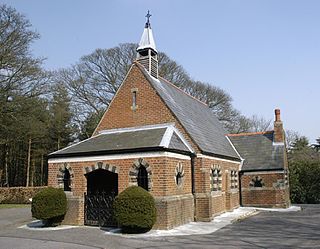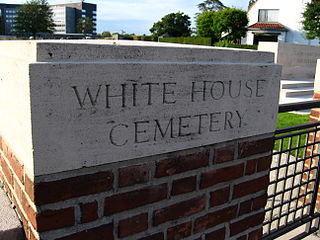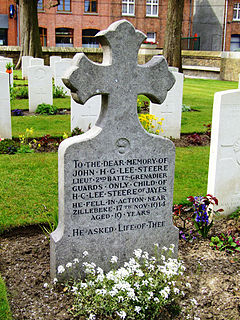History
The war cemetery was established in April 1918 during the Battle of the Lys for use by British field ambulances and fighting units. The cemetery, located in a field near the hamlet of Ouderdom on the Poperinge-Wijtschate road, was originally called "Ouderdom Military Cemetery" but later renamed after the stream Grootebeek (or Groote Kemmelbeek) which runs beside it. The cemetery was designed by W.H. Cowlishaw.

The Battle of the Lys from 7 to 29 April 1918, was part of the 1918 German offensive in Flanders during World War I, also known as the Spring Offensive. It was originally planned by General Ludendorff as Operation George but was reduced to Operation Georgette, with the objective of capturing Ypres, forcing the British forces back to the channel ports and out of the war. In planning, execution and effects, Georgette was similar to Operation Michael, earlier in the Spring Offensive.

Poperinge is a municipality located in the Belgian province of West Flanders, Flemish Region, and has a history going back to medieval times. The municipality comprises the city of Poperinge proper and surrounding villages. The area is famous for its hops and lace.
First World War
The village of Reningelst was in Allied hands from the autumn of 1914 to the end of the First World War. The site near the hamlet of Ouderdom was used for burials of soldiers until the end of September 1918. It absorbed a number of earlier burials and memorials from the area. From March 1915, Commonwealth burials had been made in Reningelst Churchyard, the Reningelst Churchyard Extension and the Reningelst New Military Cemetery, and a small Indian cemetery had been created at the site of the present-day Grootebeek British Cemetery in April 1915.
Second World War
During the Second World War, the Grootebeek British Cemetery was used again. The two burials from this time date from May 1940 and the withdrawal of the British Expeditionary Force ahead of the German advance.
This page is based on this
Wikipedia article Text is available under the
CC BY-SA 4.0 license; additional terms may apply.
Images, videos and audio are available under their respective licenses.

The Thiepval Memorial to the Missing of the Somme is a war memorial to 72,337 missing British and South African servicemen who died in the Battles of the Somme of the First World War between 1915 and 1918, with no known grave. It is near the village of Thiepval, Picardy in France. A visitors' centre opened in 2004. Designed by Sir Edwin Lutyens, Thiepval has been described as "the greatest executed British work of monumental architecture of the twentieth century".

Tyne Cot Commonwealth War Graves Cemetery and Memorial to the Missing is a Commonwealth War Graves Commission (CWGC) burial ground for the dead of the First World War in the Ypres Salient on the Western Front. It is the largest cemetery for Commonwealth forces in the world, for any war. The cemetery and its surrounding memorial are located outside of Passchendale, near Zonnebeke in Belgium.

Larch Wood Cemetery is a Commonwealth War Graves Commission (CWGC) burial ground for the dead of the First World War located in the Ypres Salient on the Western Front in Belgium.

Ypres Reservoir Cemetery is a Commonwealth War Graves Commission (CWGC) burial ground for the dead of the First World War located in the Ypres Salient on the Western Front.

Duhallow ADS Cemetery is a Commonwealth War Graves Commission burial ground for the dead of the First World War located near Ypres on the Western Front in Belgium.

Aldershot Military Cemetery is a burial ground for military personnel, or ex-military personnel and their families, located in Aldershot Military Town, Hampshire. The cemetery is also open for the interment of husbands, wives and children of all ranks, and for some civilians who have spent their working life with the armed services.
Brandhoek is a small hamlet in Belgium situated between Ieper, Vlamertinge and Poperinge just off the N308/N38.

Streatham Park Cemetery is a cemetery and crematorium on Rowan Road in Streatham Vale which is managed by Lambeth London Borough Council. The South London Crematorium is situated within the cemetery grounds and opened in 1936.

White House Cemetery is a Commonwealth War Graves Commission (CWGC) burial ground for the dead of the First World War located in the Ypres Salient on the Western Front in Belgium.

Suffolk Cemetery is a Commonwealth War Graves Commission (CWGC) burial ground for the dead of the First World War located in Kemmel in the Ypres Salient on the Western Front.

The Voormezeele Enclosures are Commonwealth War Graves Commission (CWGC) burial grounds for the dead of the First World War located in the Ypres Salient on the Western Front.

Buffs Road Cemetery is a Commonwealth War Graves Commission burial ground for the dead of the First World War located near Ypres in Belgium on the Western Front.

Zillebeke Churchyard Commonwealth War Graves Commission Cemetery forms part of the village churchyard located around the Catholic parish church of Zillebeke in Belgium.

Spanbroekmolen British Cemetery is a Commonwealth War Graves Commission (CWGC) burial ground for the dead of the First World War located in the Ypres Salient on the Western Front in Belgium. It is located at Spanbroekmolen, on one of the highest points of the Messines Ridge.

Masnieres British Commonwealth War Graves Commission Cemetery is a small Commonwealth War Graves Commission (CWGC) burial site for British Empire troops killed during the First World War Battle of Cambrai (1918) between September–October 1918. It also contains a number of German graves, although these are mostly unidentified.

Essex Farm Cemetery is a World War I, Commonwealth War Graves Commission burial ground within the John McCrae Memorial Site near Ypres, Belgium. There are 1,204 dead commemorated, of which 104 are unidentified. The cemetery was designed by Sir Reginald Blomfield and has an area of 6,032 square metres (64,930 sq ft).

Lijssenthoek Military Cemetery is a Commonwealth War Graves Commission (CWGC) burial ground for the dead of the First World War in the Ypres Salient on the Western Front. After Tyne Cot, it is the second largest cemetery for Commonwealth forces in Belgium. Lijssenthoek Military Cemetery is located near Poperinge in the province of West Flanders. Most of those buried in the cemetery are war casualties who had been wounded near Ypres and later died in the four large Allied casualty clearing stations located in this area.

Adinkerke Military Cemetery is a Commonwealth War Graves Commission (CWGC) burial ground for the dead of the Western Front of the First and Second World War. It is located near Adinkerke in the municipality of De Panne in western Belgium, close to the French border. The cemetery is surrounded by farmland and can only be reached via a 50-metre grassed path which is not suitable for vehicles.
Etretat Churchyard is a war grave in Étretat, Normandy, France, maintained by the Commonwealth War Graves Commission. It was originally the civil graveyard of Église Notre-Dame in that town.





























